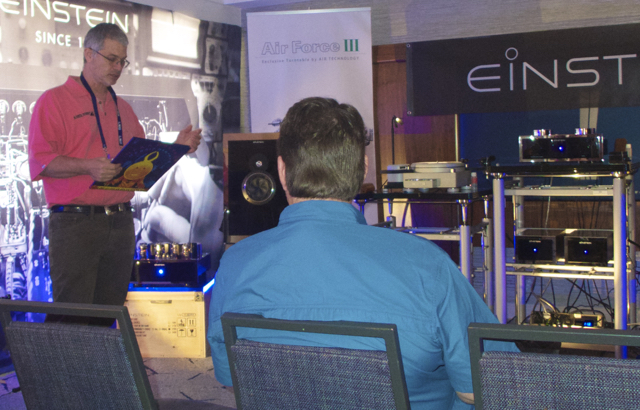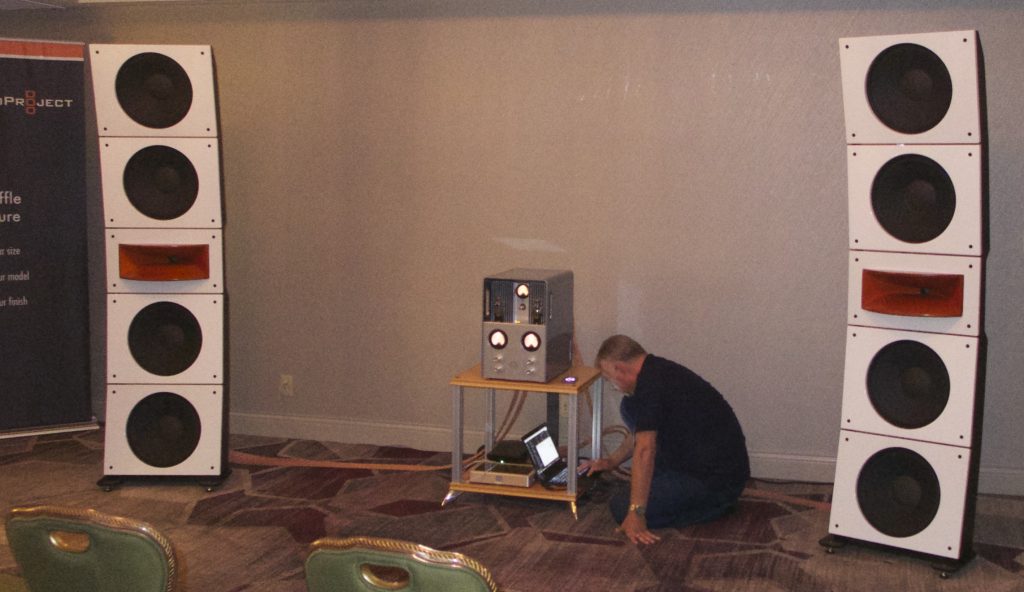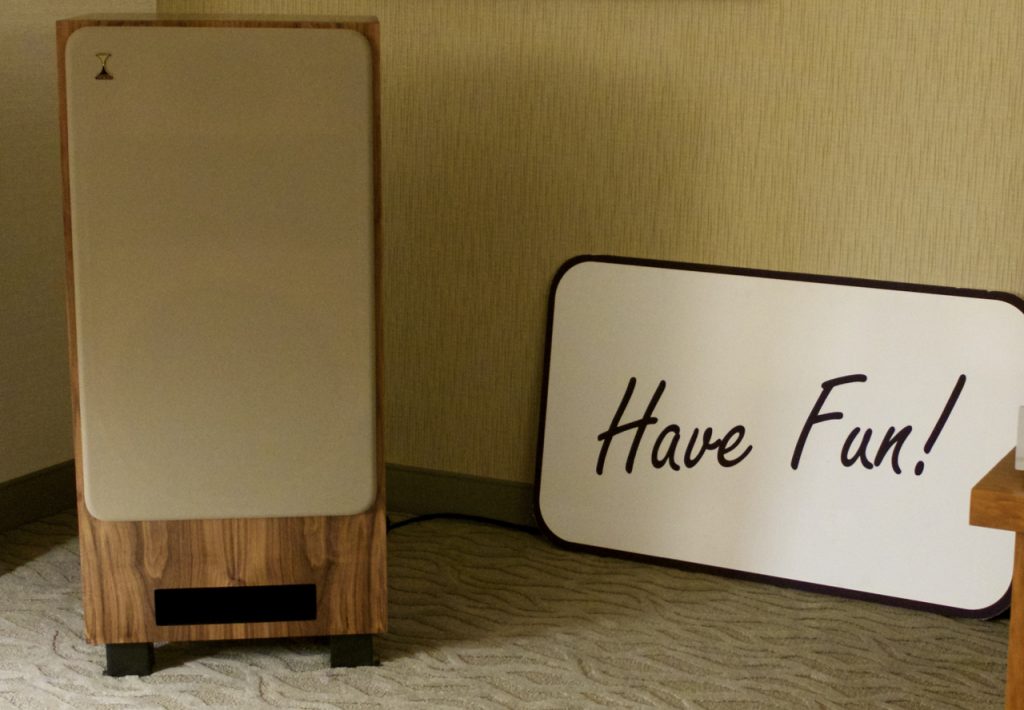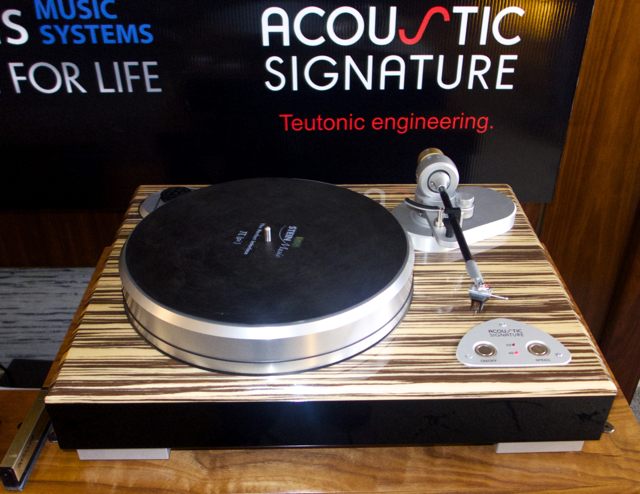
Audio shows are not like an automobile or boat shows. You don’t go to audio shows just to see the newest, best equipment and sometimes some great vintage equipment. No! We go to audio shows expecting the most exotic audio equipment in the industry to perform great in a hotel room. A room that often is not as big as the one we might have for an office system. Other rooms are large conference rooms that need a P.A. system, not a high-end system to fill them with sound.
Just think about what a Ferrari dealer would say if you asked him to take you on a test drive around the inside of the civic center. Heck, you need to take a Ferrari to a track or at least to Highway 1 on the coast of Northern California to have any idea how capable it is of performing like you expect. Truth is, a small Italian scooter would outperform the Ferrari inside a civic center. It’s not much different in the audio world. Often audio systems that use small speakers also perform best at audio shows.

With the proliferation of audio shows, we have seen some improvement in the sound of rooms at audio shows. There are companies that have gotten very adept at getting much better sound from rooms at hotels. It especially helps that some of the shows use the same hotels year after year. So, the quality of the sound at audio shows has gone up considerably in the last few years. Still, this year I heard several systems at the LA Audio Show and then the same systems at the California Audio Show, some sounded better at one show or the other.
Great Experiences at Audio Shows
Still, there are some wonderful things about audio shows. First, is that in the US these days we have fewer and fewer local dealers and at the same time there is more and more high-end equipment available. So, audio shows allow attendees to see lots of great gear they would never be exposed to otherwise. One of the best things is that you may even get to meet the designer or at least someone from the company of the equipment you are most interested in. You will probably be surprised at the time they will give you and their willingness to correspond with you and help you get what you want. Truth is by far, my favorite part of going to audio shows has always been meeting new people and seeing old friends.
One thing you may not have thought of about audio shows is that it gives you a chance to hear new music. Please don’t make the mistake of only listening to the music you bring with you. There are some exhibitors that I always ask to pick something they don’t think I’ve heard before. Two of these are Jeffrey Catalano of High Water Sound and the Zu Audio guys. I’m always hearing people complain about just hearing Diana Krall or audiophile music played at audio shows. I don’t know what shows they go to or which rooms you migrate to, but this is not my experience. For example, the guys at Zu are always spinning a lot of great tunes, many I am not familiar with. At the California Audio Show this year they introduced me to South African Classic Rock. At the LA Show, I used my smartphone to take pictures of twelve albums I had never heard and wanted to find. I heard these in ten different rooms by the way.
More and more shows have multiple dealers selling music at the show, this is another one of my favorite things about audio shows. Another thing that is common now are seminars where you can learn and ask questions about things like room acoustics, computer audio, setting up a turntable, how recordings are made and other subjects, and most audio shows have some live music.
Red Flags to Avoid
Now, let’s talk about some major red flags to avoid. One of the things I like to do at audio shows is stand in the hall and ask people what they thought of the sound in the room they are coming out of. There are three common complaints about the sound; it’s too bright, the bass was boomy, or there wasn’t enough bass. Let’s talk about these. I’ll start with brightness, why do so many of the systems sound bright? I heard a couple of guys on the elevator talking about this. One suggested that it was because of all the digital sources, the other guy said it was modern speaker design. I asked them if when they turned their system at home up way too loud did it tend to be bright. They said, yes, but I didn’t see a light bulb go off for either of them, so I let it go.
Truth is volume has a lot to do with it. When it gets really hot at home, and I have to listen with the air conditioner turned up and the fan running full out, my system can get a little bright. This is minor compared to the noise that one has to overcome at an audio show. The air conditioning is running full out, there are people talking, sometimes in the room but always out in the hall. There are other rooms nearby playing music very loud. Even when the effort is made to not put systems in rooms next to each other, this only helps a little. If you’re at a show just stand in the hall and listen for a minute; it’s loud!
Another thing that contributes to the bright sound is the noisy AC. Most of us with high-end systems use dedicated lines. We have found the best power cords for our system, and so on. One of the dealers had a little device I had never seen before that amplifies AC noise. I had heard it used at dealers before, and yes I heard some noise when no filtering was used, but nothing like the noise I heard from the demo at the hotel. I know that many of the rooms use expensive power conditioners, but it’s hard to overcome the amount of AC noise and RF that a modern, full-service hotel/convention center has.
Now let’s talk about bass for a few minutes. Too much or too little, it doesn’t matter; bass is a problem in every room. And it’s not just in hotel rooms but it’s also our rooms at home. I was helping set up one room at the California show, and I was walking around trying to find where the best sound was. The second best sound was with the chairs set up against the back wall; the best was in the entryway coming into the room. Well, no one wants to listen very long standing up in the entryway, and you really cut down on the number of people who can listen if you only put one row of chairs up.
One last thing that is generally forgotten is what a hodgepodge of equipment is often used in a room at an audio show. This is where companies like Audio Note or an even inexpensive company like NAPA Audio have an advantage at shows because all the equipment they use is their brand and designed as a system. Other rooms use almost the same equipment at every show, but many do not have that luxury because they are a dealer for several lines or because small companies need to go in with each other to share the cost. This is a real problem considering how many shows there are today.
How I Attend Audio Shows
Now, let me share with you how I go about attending an audio show. On Friday, I have two goals; to take pictures of as many rooms as possible and to find out which systems are in which rooms. If you can’t attend on Friday, you’ve got to try to get in what I do on Friday combined with what I do on Saturday.
On Saturday, I try to hear a little bit of each room; enough to decide if I am at all interested. I also ask people in the hall what they have heard that they like. If you see people with press passes don’t hesitate to ask them what they have heard that sounded good. I promise most of them will be flattered that you care for their opinion, and they will probably ask you the same question. I know I want you to tell me what you have heard that you like when you see me at a show. There is always a buzz about some rooms, and I don’t want to miss going back to those rooms.
Saturday after the show you should spend some time making a list in order of priority of the rooms you want to go back to on Sunday. This is the key day of a show for me. There are two reasons why; first, by Sunday the exhibitors have begun to get the best out of their rooms, and second, the crowd is smaller. So on Sunday, I get started as soon as the rooms open, and I pick the floor or area where most of my highest-ranked systems are and work my way down the list spending enough time in the rooms to come away with some idea of what I think of the system.
I do not listen for the quality of the bass, the soundstage or the top-end. I listen for how the music flows. I listen for how much or how little aliveness or presence there is in the area from the lower to upper midrange and the quality of the human voice. I like to hear something big like an orchestra or a big band. Then I want to hear something with a male vocal; male vocals are more difficult to get right and are a clear indication if something wrong in the lower midrange area. Lastly, I would like to hear something that has both plucked and bowed strings. From this, I can tell if this is a system that has components in them that I might be interested in hearing in my home.
Now, I realize that you may be going for one day, and for practical reasons, I confess that I’m often not able to attend for the entire show. If this is the case, please make Sunday the time you attend because there will be less people and better sound. It will also be the best day to be sure what you want to hear and to ask others what has impressed them. By the way, if you are looking to purchase something, check with the exhibitor near the very end of the show. I hope this advice will help you enjoy and make the best of going to an audio show.
10 Tips for Novice Attendees

A few months ago, my wife and I started working together on our website, and she attended her first big audio show. Here are some tips I shared with her that might help you navigate a show if you are a newbie.
- I like to start at the top floor and work my way down. This is because most people start at the bottom and go up. This helps maximize my time and is particularly helpful early on Friday and Saturday.
- Doors to rooms are often closed, but you can still go in. The exhibitor is simply trying to keep their sound inside their room and block out the hallway noise.
- Any open chair in a room can be yours. Don’t hesitate to sit in the best chair if it’s available.
- You do not have to stay in a room for a particular length of time. Slip out quietly when you are ready to leave.
- Talking is allowed in a room but only if others are talking. If others are seriously listening and you have a question, it’s not uncommon for the exhibitor to take your conversation outside to the hallway. They really do want to answer your questions.
- If you are interested in a product, you can ask the exhibitor if they have time to arrange a listening session for you. Depending on their schedule, they may be able to accommodate your request.
- Seminars or scheduled events generally start at the time advertised. Try to be on time.
- Wear your name tag. It helps to form a connection with exhibitors and other show attendees. Audio shows are a great place to make friends who share your interest.
- You are welcome to take photographs, but try to be as polite as possible when doing so. Rooms are often dark, and DO NOT ask for the lighting to be adjusted.
- There are usually dealers selling albums. If the albums are new, the prices are set. For used albums, the vendor may be open to negotiation.
Finally, if you see me or my wife, Becky, at a show, please say hello! Becky will talk to you, find out where you live and the names of your children, etc. I’m more reserved than Becky, but feel free to ask me your questions and let me know what you’ve heard and liked at the show or on our website. I hope to meet you at a show. And, if you read our website, let us know what you think or would like to see covered. We spend hours working on the site, and it’s gratifying to have people tell us that they read what we write.

